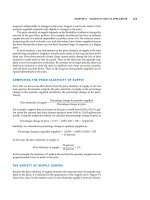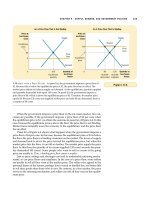Tài liệu Ten Principles of Economics - Part 21 doc
Bạn đang xem bản rút gọn của tài liệu. Xem và tải ngay bản đầy đủ của tài liệu tại đây (201.4 KB, 10 trang )
CHAPTER 10 EXTERNALITIES 209
production, the value of the aluminum to consumers (as measured by the height of
the demand curve) exceeds the social cost of producing it (as measured by the height
of the social-cost curve). The planner does not produce more than this level because
the social cost of producing additional aluminum exceeds the value to consumers.
Note that the equilibrium quantity of aluminum, Q
MARKET
, is larger than the
socially optimal quantity, Q
OPTIMUM
. The reason for this inefficiency is that the mar-
ket equilibrium reflects only the private costs of production. In the market equilib-
rium, the marginal consumer values aluminum at less than the social cost of
producing it. That is, at Q
MARKET
the demand curve lies below the social-cost curve.
Thus, reducing aluminum production and consumption below the market equi-
librium level raises total economic well-being.
How can the social planner achieve the optimal outcome? One way would be
to tax aluminum producers for each ton of aluminum sold. The tax would shift the
supply curve for aluminum upward by the size of the tax. If the tax accurately re-
flected the social cost of smoke released into the atmosphere, the new supply curve
would coincide with the social-cost curve. In the new market equilibrium, alu-
minum producers would produce the socially optimal quantity of aluminum.
The use of such a tax is called internalizing the externality because it gives
buyers and sellers in the market an incentive to take account of the external effects
of their actions. Aluminum producers would, in essence, take the costs of pollution
into account when deciding how much aluminum to supply because the tax now
makes them pay for these external costs. Later in this chapter we consider other
ways in which policymakers can deal with externalities.
POSITIVE EXTERNALITIES IN PRODUCTION
Although in some markets the social cost of production exceeds the private cost, in
other markets the opposite is the case. In these markets, the externality benefits
bystanders, so the social cost of production is less than the private cost. One ex-
ample is the market for industrial robots.
“All I can say is that if being a leading manufacturer
means being a leading polluter, so be it.”
internalizing an externality
altering incentives so that people
take account of the external effects of
their actions
210 PART FOUR THE ECONOMICS OF THE PUBLIC SECTOR
CASE STUDY
THE DEBATE OVER TECHNOLOGY POLICY
How large are technology spillovers, and what do they imply for public policy?
This is an important question because technological progress is the key to why
living standards rise from generation to generation. Yet it is also a difficult ques-
tion on which economists often disagree.
Some economists believe that technology spillovers are pervasive and that
the government should encourage those industries that yield the largest
spillovers. For instance, these economists argue that if making computer chips
Robots are at the frontier of a rapidly changing technology. Whenever a firm
builds a robot, there is some chance that it will discover a new and better design.
This new design will benefit not only this firm but society as a whole because the
design will enter society’s pool of technological knowledge. This type of positive
externality is called a technology spillover.
The analysis of positive externalities is similar to the analysis of negative ex-
ternalities. Figure 10-3 shows the market for robots. In this case, the social cost of
production is less than the private cost reflected in the supply curve. In particular,
the social cost of producing a robot is the private cost less the value of the technol-
ogy spillover. Therefore, the social planner would choose to produce a larger quan-
tity of robots than the private market does.
In this case, the government can internalize the externality by subsidizing the
production of robots. If the government paid firms a subsidy for each robot pro-
duced, the supply curve would shift down by the amount of the subsidy, and this
shift would increase the equilibrium quantity of robots. To ensure that the market
equilibrium equals the social optimum, the subsidy should equal the value of the
technology spillover.
Quantity
of Robots
0
Price
of Robot
Q
OPTIMUM
Demand
(private value)
Supply (private cost)
Social cost
Q
MARKET
Value of
technology
spillover
Equilibrium
Optimum
Figure 10-3
T
ECHNOLOGY
S
PILLOVERS AND
THE
S
OCIAL
O
PTIMUM
. In the
presence of a positive externality
to production, the social cost of
producing robots is less than the
private cost. The optimal quantity
of robots, Q
OPTIMUM
, is therefore
larger than the equilibrium
quantity, Q
MARKET
.
CHAPTER 10 EXTERNALITIES 211
yields greater spillovers than making potato chips, then the government should
use the tax laws to encourage the production of computer chips relative to the
production of potato chips. Government intervention in the economy that aims
to promote technology-enhancing industries is called technology policy.
Other economists are skeptical about technology policy. Even if technology
spillovers are common, the success of a technology policy requires that the
government be able to measure the size of the spillovers from different mar-
kets. This measurement problem is difficult at best. Moreover, without precise
measurements, the political system may end up subsidizing those industries
with the most political clout, rather than those that yield the largest positive
externalities.
One type of technology policy that most economists endorse is patent pro-
tection. The patent laws protect the rights of inventors by giving them exclusive
use of their inventions for a period of time. When a firm makes a technological
breakthrough, it can patent the idea and capture much of the economic benefit
for itself. The patent is said to internalize the externality by giving the firm a
property right over its invention. If other firms want to use the new technology,
they would have to obtain permission from the inventing firm and pay it some
royalty. Thus, the patent system gives firms a greater incentive to engage in re-
search and other activities that advance technology.
EXTERNALITIES IN CONSUMPTION
The externalities we have discussed so far are associated with the production of
goods. Some externalities, however, are associated with consumption. The con-
sumption of alcohol, for instance, yields negative externalities if consumers are
more likely to drive under its influence and risk the lives of others. Similarly, the
consumption of education yields positive externalities because a more educated
population leads to better government, which benefits everyone.
The analysis of consumption externalities is similar to the analysis of produc-
tion externalities. As Figure 10-4 shows, the demand curve does not reflect the
value to society of the good. Panel (a) shows the case of a negative consumption
externality, such as that associated with alcohol. In this case, the social value is less
than the private value, and the socially optimal quantity is smaller than the quan-
tity determined by the private market. Panel (b) shows the case of a positive con-
sumption externality, like that of education. In this case, the social value is greater
than the private value, and the socially optimal quantity is greater than the quan-
tity determined by the private market.
Once again, the government can correct the market failure by inducing market
participants to internalize the externality. The appropriate response in the case of
consumption externalities is similar to that in the case of production externalities.
To move the market equilibrium closer to the social optimum, a negative external-
ity requires a tax, and a positive externality requires a subsidy. In fact, that is ex-
actly the policy the government follows: Alcoholic beverages are among the most
highly taxed goods in our economy, and education is heavily subsidized through
public schools and government scholarships.
As you may have noticed, these examples of externalities lead to some gen-
eral lessons: Negative externalities in production or consumption lead markets to pro-
duce a larger quantity than is socially desirable. Positive externalities in production
212 PART FOUR THE ECONOMICS OF THE PUBLIC SECTOR
or consumption lead markets to produce a smaller quantity than is socially desirable. To
remedy the problem, the government can internalize the externality by taxing goods that
have negative externalities and subsidizing goods that have positive externalities.
QUICK QUIZ: Give an example of a negative externality and a positive
externality. ◆ Explain why market outcomes are inefficient in the presence of
externalities.
PRIVATE SOLUTIONS TO EXTERNALITIES
We have discussed why externalities lead markets to allocate resources ineffi-
ciently, but have mentioned only briefly how this inefficiency can be remedied. In
practice, both private actors and public policymakers respond to externalities in
various ways. All of the remedies share the goal of moving the allocation of re-
sources closer to the social optimum. In this section we examine private solutions.
THE TYPES OF PRIVATE SOLUTIONS
Although externalities tend to cause markets to be inefficient, government action
is not always needed to solve the problem. In some circumstances, people can de-
velop private solutions.
Quantity
of Alcohol
0
Price of
Alcohol
Q
MARKET
Demand
(private value)
Supply
(private cost)
Social value
Q
OPTIMUM
(a) Negative Consumption Externality
Quantity of
Education
0
Price of
Education
Q
MARKET
Demand
(private value)
Social
value
Q
OPTIMUM
(b) Positive Consumption Externality
Supply
(private cost)
Figure 10-4
C
ONSUMPTION
E
XTERNALITIES
. Panel (a) shows a market with a negative consumption
externality, such as the market for alcoholic beverages. The curve representing social value
is lower than the demand curve, and the socially optimal quantity, Q
OPTIMUM
, is less than
the equilibrium quantity, Q
MARKET
. Panel (b) shows a market with a positive consumption
externality, such as the market for education. The curve representing social value is above
the demand curve, and the socially optimal quantity, Q
OPTIMUM
, is greater than the
equilibrium quantity, Q
MARKET
.
CHAPTER 10 EXTERNALITIES 213
Sometimes, the problem of externalities is solved with moral codes and social
sanctions. Consider, for instance, why most people do not litter. Although there are
laws against littering, these laws are not vigorously enforced. Most people do not
litter just because it is the wrong thing to do. The Golden Rule taught to most chil-
dren says, “Do unto others as you would have them do unto you.” This moral in-
junction tells us to take account of how our actions affect other people. In
economic terms, it tells us to internalize externalities.
Another private solution to externalities is charities, many of which are estab-
lished to deal with externalities. For example, the Sierra Club, whose goal is to pro-
tect the environment, is a nonprofit organization funded with private donations. As
another example, colleges and universities receive gifts from alumni, corporations,
and foundations in part because education has positive externalities for society.
The private market can often solve the problem of externalities by relying on
the self-interest of the relevant parties. Sometimes the solution takes the form of in-
tegrating different types of business. For example, consider an apple grower and a
beekeeper that are located next to each other. Each business confers a positive ex-
ternality on the other: By pollinating the flowers on the trees, the bees help the or-
chard produce apples. At the same time, the bees use the nectar they get from the
apple trees to produce honey. Nonetheless, when the apple grower is deciding
how many trees to plant and the beekeeper is deciding how many bees to keep,
they neglect the positive externality. As a result, the apple grower plants too few
trees and the beekeeper keeps too few bees. These externalities could be internal-
ized if the beekeeper bought the apple orchard or if the apple grower bought the
beehive: Both activities would then take place within the same firm, and this sin-
gle firm could choose the optimal number of trees and bees. Internalizing exter-
nalities is one reason that some firms are involved in different types of business.
Another way for the private market to deal with external effects is for the in-
terested parties to enter into a contract. In the foregoing example, a contract be-
tween the apple grower and the beekeeper can solve the problem of too few trees
and too few bees. The contract can specify the number of trees, the number of bees,
and perhaps a payment from one party to the other. By setting the right number of
trees and bees, the contract can solve the inefficiency that normally arises from
these externalities and make both parties better off.
THE COASE THEOREM
How effective is the private market in dealing with externalities? A famous re-
sult, called the Coase theorem after economist Ronald Coase, suggests that it can
be very effective in some circumstances. According to the Coase theorem, if pri-
vate parties can bargain without cost over the allocation of resources, then the pri-
vate market will always solve the problem of externalities and allocate resources
efficiently.
To see how the Coase theorem works, consider an example. Suppose that Dick
owns a dog named Spot. Spot barks and disturbs Jane, Dick’s neighbor. Dick gets
a benefit from owning the dog, but the dog confers a negative externality on Jane.
Should Dick be forced to send Spot to the pound, or should Jane have to suffer
sleepless nights because of Spot’s barking?
Consider first what outcome is socially efficient. A social planner, considering
the two alternatives, would compare the benefit that Dick gets from the dog to the
cost that Jane bears from the barking. If the benefit exceeds the cost, it is efficient
Coase theorem
the proposition that if private
parties can bargain without cost over
the allocation of resources, they can
solve the problem of externalities on
their own









